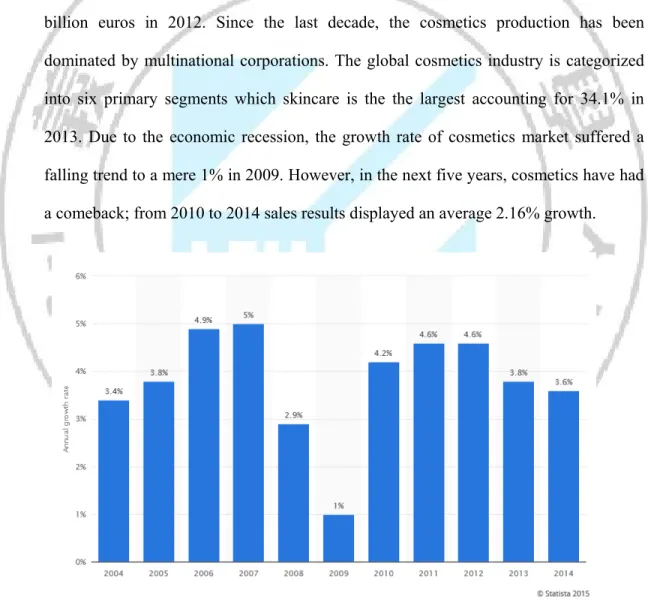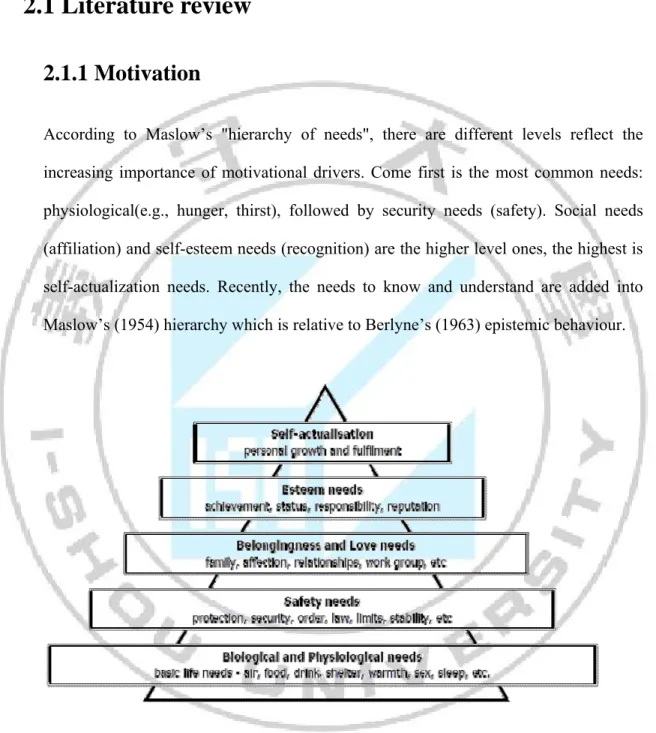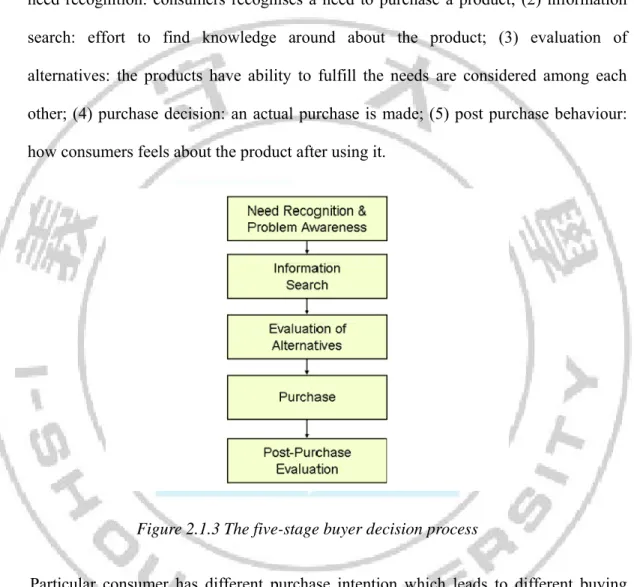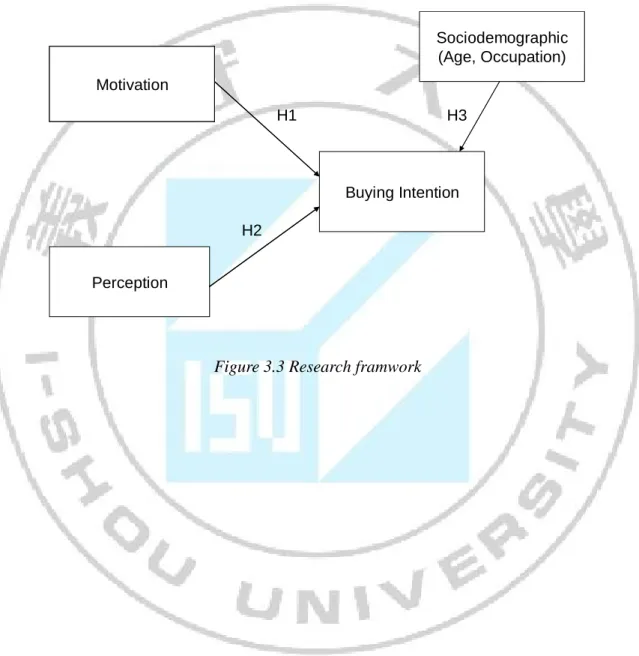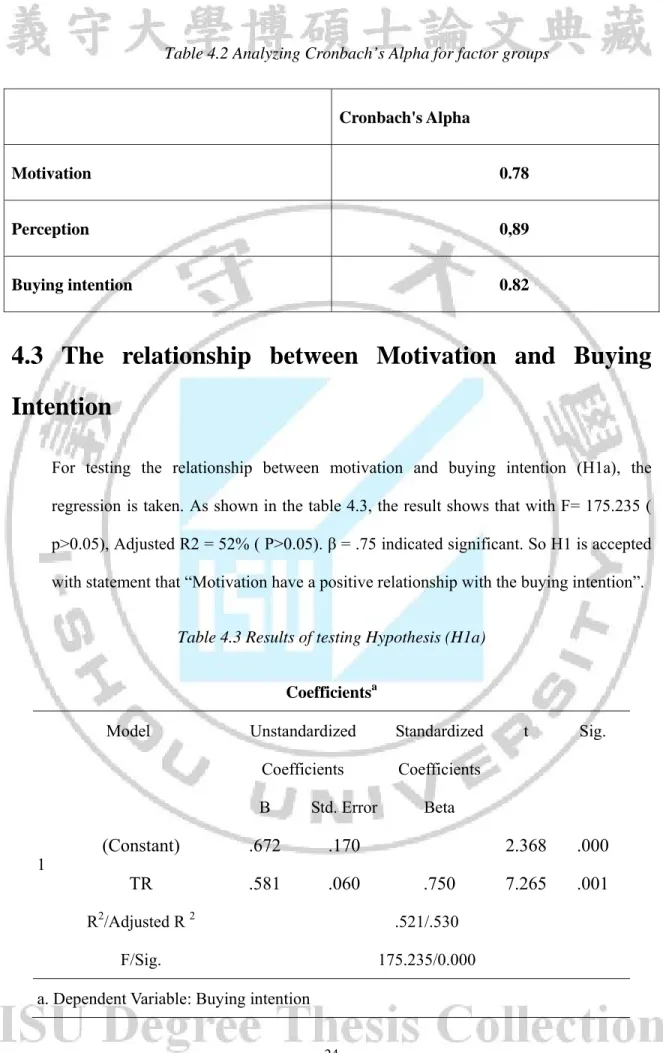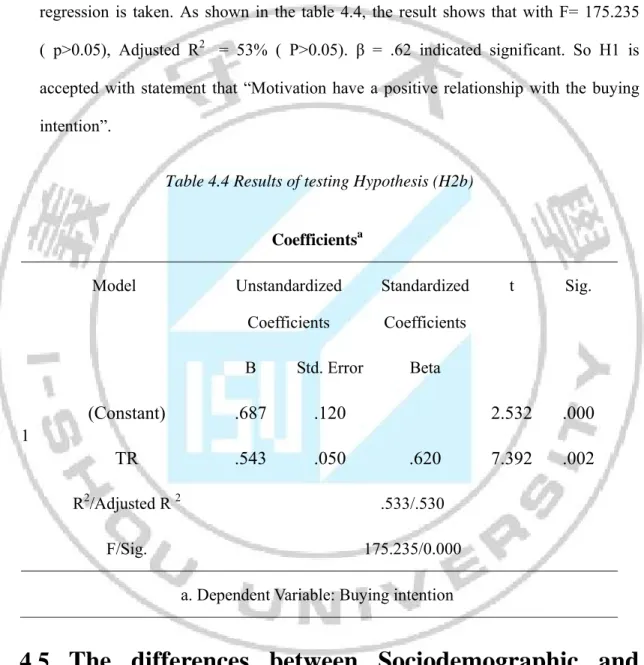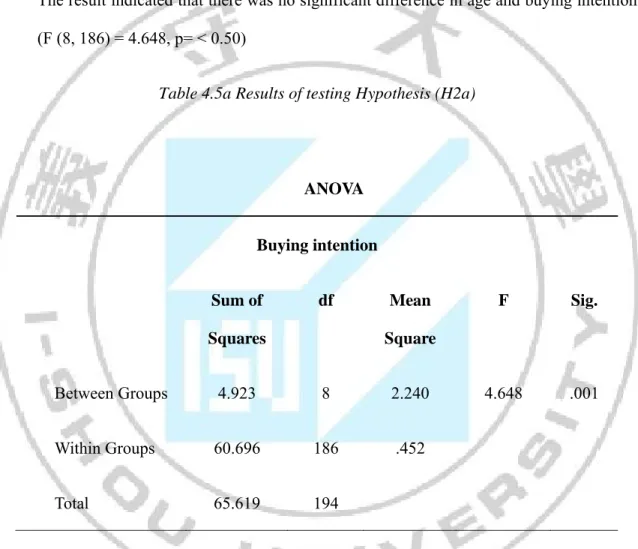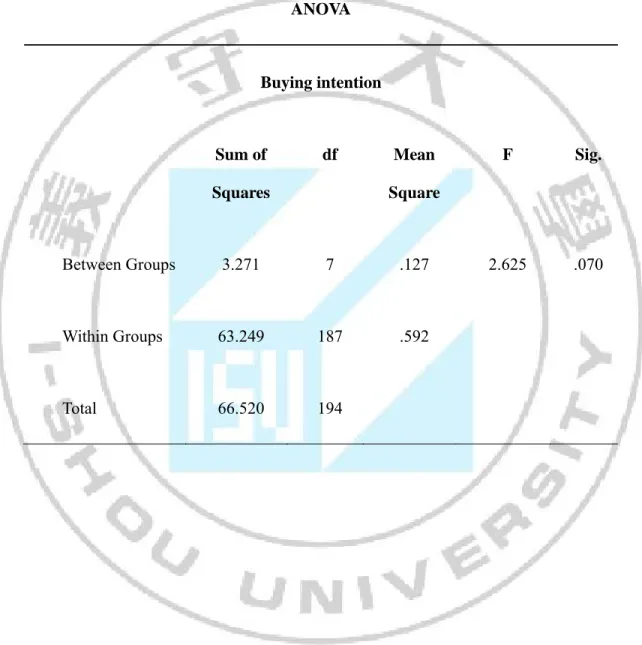Department of Business Administration
I-Shou University
Master Thesis
Motivation, Perception and Intention to
Purchase in Perfume Business: The case of
consumers in Hanoi, Vietnam
Advisor
:
Dr.
Jiin-Ling
Lin
Co-Advisor : Dr. Nguyen Quang Vinh
Graduate Student : Bui Khanh An
Acknowledgements
Firstly, I want to say thanks to my advisors, Dr. Jiin-Ling Lin and Dr. Nguyen Quang Vinh for supporting me with constructive recommendations and motivating me to complete this research paper. Their guildance and assistance were precious to my work.
Secondly, this research paper is unable to be completed without the great help of teachers and lecturers in Hanoi University of Bussiness and Technology (HUBT) and I-Shou University. I want to express my grateful thanks to them and hope we could have other opportunities to work together in the future.
Finally, I would like to give thanks to my family for staying by my side and encouraging me to complete this study.
Abstract
The study was to investigate the perfume consumers’ purchasing behavior and its association with motivation and perception in Hanoi. Data for this study was obtained through self-administered using convenience sampling. A total of 195 usable samples were collected in Royal City Shopping Mall and MIPEC Tower in Hanoi City. Results revealed that there was a relationship between motivation, perception and intention to purchase to the perfume consumers in Hanoi. This study is important to the cosmetic marketers to understand the consumer’s purchasing behavior on perfume. The marketers also could understand the market segmentation and make them to be more competitive and utilize target market wisely. Results showed that there was a relationship between perception and intention to purchase to the perfume consumers. Results indicated that there was a difference between age and intention to purchase of respondent and there was no difference between buying intention and occupation. Implications of the findings for marketers and research limitations are also discussed.
Table of Contents
Acknowledgements ... i
Abstract ... ii
List of Tables ... v
List of Figures ... vi
Chapter 1
INTRODUCTION ... 1
1.1 Research Background ... 2
1.1.1 Global Fragrance market: ... 2
1.1.2 Vietnam Frangrance market ... 4
1.1.3. Consumer’s Buying Behaviour ... 5
1.2 The purpose of this study ... 6
1.3 Research contribution ... 6
2.1 Literature Review ... 7
2.1.1 Motivation ... 7
2.1.2 Perception ... 10
2.1.3 Buying intention ... 11
2.1.4 The relationship between motivation, perception and consumer purchasing intention ... 13
2.1.5 The relationship between sociodemographic and buying intention ... 14
2.2 Cosmetics maket in Vietnam ... 15
3.1 Instrument design ... 16
3.2 Statiscal analysis intrument ... 17
3.3.1 Reliability test ... 17
3.3.2 Linear regression ... 17
3.3.3 ANOVA ... 18
3.3 Reseach question and framework: ... 18
Chapter 4
RESULTS AND FINDINGS ... 20
4.1 The profile of the respondents ... 20
4. 2 Reliability Cronbach’s Alpha ... 23
4.3 The relationship between Motivation and Buying Intention ... 24
4.4 The relationship between Perception and Buying intention ... 25
4.5 The differences between Sociodemographic and Buying intention ... 25
Chapter 5
CONCLUSION AND SUGGESTION ... 28
5.1 Research summary ... 28
5.2 Theoretical and Practical Implications ... 29
5.3 Research limitations ... 29
References ... 30
List of Tables
Table 4.1a Respondent profile ... 21
Table 4.1b Respondent’s view on their perfume purchase intention, motivation and perception .. 22
Table 4.2 Analyzing Cronbach’s Alpha for factor groups ... 24
Table 4.3 Results of testing Hypothesis (H1a) ... 24
Table 4.4 Results of testing Hypothesis (H2b) ... 25
Table 4.5a Results of testing Hypothesis (H2a) ... 26
List of Figures
Figure 1.1.1 Annual growth of the global cosmetics market from 2004 to 2014 ... 2
Figure 2.1.1 Maslow’s hierachy of needs ... 7
Figure 2.1.3 The five-stage buyer decision process ... 12
Chapter 1 INTRODUCTION
In the recent years, the demand for fragrance in Vietnam comes up to the level higher than ever before. Perfumes are adored by millions of people around the world contributing to building self-esteem for individuals. Thousands of perfume bottles are bought everyday which greatly enhances the global perfume industry. Vietnam has a population of 90 millions and young generations which is potential for cosmetics industry as well as perfume industry to invest. The most important elements for any perfume companies demanding to develop the marketing strategies as well as remain the loyal consumers and attract new ones. According to Ajzen and Fishbein(1980) built up The Theory of Reasoned Action (TRA) and Theory of Planned Behavior (TPB) to explain how a person leads to certain behavior. The crucial factor in the theories is the individual’s intention to perform a given behavior. To understand how consumers make their buying decision, we need to know their buying intention. Intention to purchase is the individual’s motivation in the sense of her or his intention to present behavior. Currently, a large portion of perfume products sold are imported from developed countries which means domestic products are not appealed enough for local consumers. In order to better designing effective marketing plan to attract perfume consumers to buy domestic products, this study attempted to examine consumers’ motivations and perceptions to consumer’s buying decision.
1.1 Research Background
1.1.1 Global fragrance market:
The Cosmetics Industry is one of the largest part in The Beauty and Personal Care industry. Cosmetics firms merchandize makeup/color cosmetics, skin and suncare products, fragrances, toiletries, and numerous other grooming products. According to a report by The Statista (2015) the global cosmetic market achieved approximately 180 billion euros in 2012. Since the last decade, the cosmetics production has been dominated by multinational corporations. The global cosmetics industry is categorized into six primary segments which skincare is the the largest accounting for 34.1% in 2013. Due to the economic recession, the growth rate of cosmetics market suffered a falling trend to a mere 1% in 2009. However, in the next five years, cosmetics have had a comeback; from 2010 to 2014 sales results displayed an average 2.16% growth.
Nowadays, the perfume market performs the most important role in the cosmetics and toiletries industry. A report by Global Industry Analysist, Inc. (2015), claims that woman’s perfume segment has been leading the whole market and predicted to create steady demand over the following years. The men’s perfume segment is also predicted to achieve stronger growth than ever before thanks to the adjustment in perception towards the priority of male grooming. Fragrances, once considered as non-essential items, have gradually transformed themselves into must-have product that form a great part of personal grooming. Fragrances are a method of expressing individual style, thereby making it a consumer-driven isdustry. The fragrance market is also controlled by fickle and ever-changing fashion trends. Based on a 2012 report, the global perfume industry is valued at around $28 billions (Kafkaesque 2014) and estimated at nearly $30 billions in 2013 according to market research company Mintel. A recent report by Global Industry Analysts predicts the global perfume markets will reach about $456 billions by 2018.
Matt Bodimeade (2013) states: “The market is set to benefit from the growing trend towards consumer urbanization, higher spending propensity and the heightened importance on personal appearance and grooming. In addition, increased demand for youth-oriented floral and exotic fragrances and celebrity perfumes will set the pace for rapid market expansion.” Companies are attempting to tap into this lucrative market by publishing more and more new fragrances each year. Jordan River of The Fragrant Man, has post in Michael Edwards new book: Fragrances of the World, which describes the boost in the number of perfume released each year. Jordan wirtes: “In 1993 there were 132 new perfume releases, by 2003 the number had grown to 581. As noted above, 2012 saw 1330 releases and in 2013 retail shelves made room for a futher 1492 new perfumes.”
1.1.2 Vietnam fragrance market
According to a merket research by company Mintel(2014), the global fragrance market approach to $30 billions in 2013, with Indonesia, India and Vietnam amongst the fastest growing markets. Except for Japan, the Asian fragrance marketplace is rapidly developing at a fast pace. Vietnam recorded a CAGR of 15%, South Korea 12%, Indonesia 44% and India 25% over the last five years.
The rapid growth of middle class as well as the widespread aspiration of Western lifestyles, international brands have potential to develop their fragrance bussiness. Vietnam is certainly a rising star- however the market share is migrating from domestics companies to the multinations. The local brands has to fight back with innovations and advanced technology.
Miss Saigon is a famous perfume brand name of Saigon Cosmetics Corporation(SCC) which has gain achivements of customers both local and abroad for many years. Its shape illustrates the Vietnames lady wearing a traditional clothes called Ao dai and a conical leaf hat. Until 2012, Saigon Group held the no.1 position. However, its market share has fallen nearly three points to 14.9% because of the fact that direct sellers such as Oriflame and Avon and other international brand have gained strength.
With the population of 90 millions, Vietnam becomes a potential market for this segment. According to Euromonitor International (2014), there was a strong growth recorded in Vietnam fragrance market in 2010, about 21.2% approximate 21.5 millions USD.
In 2012, fragrance market recorded a value growth rate of 19%. An article in Euromonitor (2012) states about 92% of fragrances sold are imported which indicates
that domestic products seem not really appeal to local consumers. Article also points out that the loyalty of the consumer is very important in fragrance business. Perfume companies have to invest a huge resource every year to take care of their loyal customers. Conducting reseaches to indentify what consumers concern and develop strategies to gain back the customers are what a dosmetic perfume company in Vietnam need to execute now.
1.1.3. Consumer’s buying behaviour
Studies of consumer behaviour usually involve in determination of consumers and their buying behaviour(William, 1951). Engel, Blackwell and Miniard(1995) indicated that customer behavior associated with collecting, consuming and disposing of services and products, containing the making decision process that come first and follow these actions. Therefore, determining the indicators which have impaction on the buying behaviour could raise the sales revenue. According to The Theory of Reasoned Action (Ajzen&Fishbein, 1980), a person’s behavioural intention is determined by the two basis components which are attitude toward behaviour and subjective norm. The combination of these two indicators will directly impact on an individual’s behavioural intention which is said to be equal to behaviour (Suddin, Geoffrey and Hanudin, 2009). Whitlark, Geurts and Swenson (1993) describe buying intention as a purchase probability involved in an intention classification at the percentage of individuals that will actually buy product.
Stallworth (2008) defines consumer buying behaviour is a group of activities which associates with the puchase and disposing of products and services which originates from the consumer’s emotional and metal needs and behavioural responses. Gabbot and Hogg (1998) state that the consumer making decision process may include various
activities and stages. Consumer buying behaviour is considered as a complex, intense issue which cannot be determined easily and commonly. The definition of consumer buying behaviour consequently has been indentified in Therefore, the concept of consumer buying behaviour has been defined in disparate ways by disparate researchers. In this current study, we define consumer purchase intention as consumer who make a purchase and plan to repeat it.
1.2 The purpose of this study
The purpose of this study is to examine the relationship between motivation and perceptions to the perfume consumer in Hanoi, Vietnam.
1.3 Research contribution
The study is an attempt to investigate the consumers perfume purchasing behavior as well as its association with consumers’ perception and motivation. This study has practically contributions to the understanding about currently cosmetic consumers behaviors and those findings can provide useful information for effective marketing plan.
Chapter 2 LITERATURE REVIEW
2.1 Literature review
2.1.1 Motivation
According to Maslow’s "hierarchy of needs", there are different levels reflect the increasing importance of motivational drivers. Come first is the most common needs: physiological(e.g., hunger, thirst), followed by security needs (safety). Social needs (affiliation) and self-esteem needs (recognition) are the higher level ones, the highest is self-actualization needs. Recently, the needs to know and understand are added into Maslow’s (1954) hierarchy which is relative to Berlyne’s (1963) epistemic behaviour.
Consumer has crucial role in market and contains different characteristics that response dissimilarily to every single product. Schiffman & Kanuk (2007) indicated that lifestyle of an individual or a family has an impact on their consuming behaviour. Therefore, the process of consumer making buying decision is very unique and affects the market eventually. If the consumers spend their income to purchase services or goods would bring positve influence to the market. Consumer’s buying behaviour may be influenced by various external and interal factors.
Over the last decade, companies are making effort to boost their investments in the innovation and brand development. American Marketing Association (AMA) claims that a brand is a combination of name, sign, symbol and term which help differentiate firms with their competiontion. Keller (2008) consider brand has fuction to create reputation, awareness and expectation in the marketplace. Once consumers get accustomed to a definite brand, they stay steadily with that and do not easily accept subtitutes.
Watson (2003) argues that price is considered simply as cost representing the actual value of the products. However, Jalees (2007) claims that price is also a non-product attibution to a brand perception, higher prices means luxury and qualified goods. The luxury products will not be luxury and exclusive anymore if they are not priced high.
Hoyer and Maclnnis (2008) argues that consumers are appealed to an attracting, eye-catching models or celebrities representing the glamor of the product or brand. In the luxury perfume industry, everthing from the package outside to the bottle inside and the face all chosen carefully to create dreams and sparkles even for months before the fragrance itselft would be released(Osmoz Magazine).
Tinne (2011) argues that the unintended factors suitable enough to influence consumer to purchase. Tinne claims that promotion activities, discount offer, sale person behaviour, idolazation of product, affection of reference group, display of product, income level or even festival season are certain variables on consumer impulse behaviour.
Coob, Cathy and Hoyer (1986) as cited in Shoham and Brencic (2003) claims that male consumers were more likely to plan less than female consumers before they decide to purchase. Albano, Jake, Larissa and Bill (2011) did a research from a gender perspective to figure what really influence these different gender to purchase. The research addresses how effective advertising campaigns are, the role of sales technique and other factors. The outcome of the research points out that when a 18-22 year old male is buying perfume for his mother, a model or celebrity print ad is irrelevant. On the other hand, 18-22 year old males are supposed to purchase a perfume with a sale promotion than females are and they also tend to seek help from sale person when buying a perfume than 18-22 year old females.
Statista (2015) reports global advertisement expenditure in 2011 was approximately 481.6 billion USD. Niazi et al (2012) states advertising is a method of communication to persuade viewers to make purchase decision and provide information to them. Advertising has outstanding impact on audience’s mind (Katke, 2007) and its major purpose is to reach potential customers and influence their buying behaviour(Ayanwale et al., 2005). Everyyear, companies spend huge investments on promotional purpose (Hussainy et al., 2008). A research conducted by Kaur and Kaur (2002) shows that television is the most crucial media of all. Saksena (1990) argues that young generation is more influenced by television and intends to purchase products of the brands being
advertised more on television. A research executed by Ernst&Young (2000) performs that 79% of non-buyer intended to make a purchase via the Internet.
As the scope of this study the writer finds that consumer motivation is an inner element that lead people to determine and purchase products or services that satisfy conscious and unconscious demands. These fulfillment contribute to motivate people to make a re-purchase or to seek different better products and services.
2.1.2 Perception
Chris Blank (2013) states that perception of consumer relates to how people perceive and building opinions about firms and the goods they offer. Companies absorb consumer perception review to create marketing and advertising strategies aimed to retain loyal customers and appeal new ones.
Shaw, R., and Laura (1997) claim that the researchers need to figure out what goes on in the mind or the thought process of consumer to determine factors affecting the purchase of perfume. Product consideration, product categories and abtract causality of consumer are factors directly affecting consumer’s final decision.
Retiveau (2004) applies various instrument to understand the individual difference of perfume perception. He found that demographic and psychologycal differences only reflect motivation and attitudes toward perfume but not explain the behavioral patterns. So the combination of perfume perception and personality associations as well as perfume hedonic and intrinsic sensory characteristics was necessary to understand model of personlity triats and image associated with perfumes.
Dhar et al (2008) after conducting research on customer’s usage of fragrance, claims that fragrance has a strong position among all factors provided by reseach respondents.
Verma (2009) claims that types of advertising are tools for bring the image of goods and services to consumers and then strongly affect consumer’s purchasing behaviour.
As the scope of this study the writer indicates that perception is a inside-mind procedures of selecting, organizing and expilcate sensations into a consequential whole.
2.1.3 Buying intention
Most companies invest an amount of budget on doing research of consumer behavior as well as consumer behavioural intention. The main objective of consumer buying behaviour analysis is to indentify the indicators that consumers perform in different situations like in economics aspect (Ayanwale et al., 2005). Consumer buying behaviour analysis is useful for marketers to understand the consumer purchase decision.
Bromley (1993) states that behaviour of consumer are impacted by many factors which include their wants and needs, their desires, their attitudes and expectation, their finacial situation and their decisions processes.
Solomon (2006) states that consumer behaviour is the study of the procedures related to how individuals or groups select, make a purchase, utilize or dispose the products or services to fulfill needs and desires. Schiffman, L., Hansen H. and Kanuk L. (2007) also agrees that all the behaviour that consumers conduct in seeking, purchasing, using, appraising and disposing products or services are to satisfy their demands.
The consumer behaviour is a necessary element indicating the process of making decision in purchasing a perfume. Engel (1995) claims that the consumer’s buying decision is influenced by internal factors such as: perception, motivation, knowledge, consumer resources, personality, attitudes, value and lifestyle. Besides, the
decision-process behaviour is also affected by cultural background, personal influence, social class, reference froup and situation.
Kotler and Keller (1996) built up the five-stage buyer decision process containing: (1) need recognition: consumers recognises a need to purchase a product; (2) information search: effort to find knowledge around about the product; (3) evaluation of alternatives: the products have ability to fulfill the needs are considered among each other; (4) purchase decision: an actual purchase is made; (5) post purchase behaviour: how consumers feels about the product after using it.
Figure 2.1.3 The five-stage buyer decision process
Particular consumer has different purchase intention which leads to different buying decision(Rashid et al, 2010). Purchase intention is supposed to affected by individual’s perceived value about the products or services (Tung et al, 1994). Design, package, advertising and other indicators have potentiality to provide consumers information about product and then create knowledges about its value. The association of consumers’ knowledge about the product with purchase intention is concluded to be positive (Franz et al, 2006) and have great impact on their buying decision(Satish &
Peter 2004). James (2002) conclude that the higher level of perceived value as well as the better consumer evaluate the products may come up to consumer buying intention.
As the scope of this study the writer consider consumer’s buying behavior is the sum total of a consumer's attitudes, preferences, intentions and decisions regarding the consumer's behavior in the marketplace when purchasing a product or service.
2.1.4 The relationship between motivation, perception and
consumer purchasing intention
This study is supposed to determine how motivation and perception impact on consumer buying behaviour in Hanoi. There is a number of different reseaches have been conducted in the study of purchasing behaviour. The write suggest using motivation and perception concerning to both internal and external factors to reseach. It is believed that psychology plays an important role in helping individual better understanding life-happening issues as well as coming up to decisions. Study of the motivation and perception gives an opportunity to determine the conditions that live within an individual and have great affection on his/her activity (Fitzmaurice, 2008).
Consumer behavior and motivation are connected in numerous ways, the most noticeable of which is the truth that consumer behavior is mostly controlled by motivation (Erin J. Hill, 2013). As consumers invest money on goods or services, Fah et al (2011) states that there must be something motivating them to act like that and this could be internal wants or needs, or it could be caused by influential advertising. No need to consider what kind of purchase is, there is always a link between consumer behaviour and motivation , due to the fact that there is always motivation to purchase
something even the products or services customer doesn’t intend to obtain (Loudon and Bitta, 1988).
Perception of consumers has a great effect on buying behaviour with products or services(Romaniuk & Sharp, 2004). That’s why companies invest huge money on marketing themselves, enhancing their customer services and execute any activities that may influence the perception of target customers.
2.1.5 The relationship between sociodemographic and buying
intention
One of the important consumer’s factors is socio-demographic which has been reseached in various studies. Impact of gender, age, occupation and income are focused on examination the most (Amaldoss and Sanjay, 2002). A report researched by Global Industry Analysist, Inc. (2015), indicates that fragrance and perfume market is driven by the young aging population, which means the teenagers and young adults are purchasing perfume more than the older group. Haugtvedt and Cacioppo. (1992) indicates that demographic is a category of customers that share a collection of market-relevant attributes which may contain physical patterns, beliefs, experiences or financial elements that may be useful to create awareness, loyalty, sales volume or product improvement.
Hawkins, Neal, Quester and Best (1994) indicate that age is an effective determinant of consumer behaviour. Tastes, interests, finacial ability and investment intention changes consequenly regarding consumer’s age. An individual’s occupation also has impact on his or her behavioural buying intention (Engel et al, 1990). Conditions or environment at work, even the characteristics of the job can affect on consumer’s purchasing decision. In this study, the writer is interested to find out the impact of sociodemographic element
each part of the world so this study may define better how socio-demographic affect on perfume purchase behaviour of consumers in Hanoi.
2.2 Cosmetics maket in Vietnam
Over the last decades, the cosmetic industry performs a slow growth due to the economic recession. However, the Asian Pacific market sparks as the brightest star among the gloomy picture of the global cosmetic industry. According to a report of Euromonitor (2013) the Asia Pacific market is valued more than 70 billion USD which ranks the second place only after the Western European market.
Vietnam is stated to obtain the fastest growing market among Asia Pacific with the average growth rate of 14% from 2000 to 2005. Big multinational corporations such as Unilever, L’Oreal, Johnson&Johnson and P&G step by step created an dynamic and competitive maket for cosmetic segment in Vietnam.
A report published in an international article (International brands see success in Vietnam
cosmetic market 2012) stated that Vietnamese cosmetic sales are around at 150 millions
USD per year year with an annual sales increase of 30%. International brands dominate the local cosmetic market with about more than 400 cosmetics brands obtaining a large market share such as L’Oreal, Esteé Lauder, Clinique, Clarins, Shiseido, Ohui, The Face Shop, etc,. The report also noted that domestic companies were lack of effective marketing strategies and branding activities which push them into difficul stituation to gain back profitability.
Chapter 3 METHODOLOGY
3.1 Instrument design
The questionnaire of Hamid, Zekeriya and Khalid is taken for reference to developed the questionnaire in this study. Perfume purchasing behavior was measured by stating the influence of each factors mentioned. Each item has five response categories, applying the Likert Scale (1932), a five point scale raging from “1 = Strongly Disagree” to “5 = Strongly Agree” which allows to express how much repondents agree or disagree with a particular statement. The questionnaire contains 22 items, which was translated into both Vietnamese and English. The survey comprised 3 sections: (1) social-demorgraphic information of the respondents, (2) purchase motivation for perfume products, and (3) purchase perception for perfume products.
The locations to distribute survey were in Hanoi Shopping Mall. Royal City Shopping Mall and Mipec Shopping Mall was picked out of the list of shopping mall in Hanoi city including Mipec, Vincom, Times City, Royal City, Trang Tien Plaza, Ruby Plaza, ASEAN Center and Cau Giay Center. The data for determining the location was based on the list of shopping malls in Hanoi in 2011 issued by Ministry of Industry and Trade.
A total of 210 repondents were chosen randomly. The inclusion criterion in respondent selection is the individual who are currently using perfume and accepts to execute the survey. The research was implemented in April 2015.
3.2 Statiscal analysis intrument
3.3.1 Reliability test
This study firstly uses Cronbach alpha coefficient recommended by Numally (1978), which is a statistical test allows, allows assessment of the reliability of the establishment of a "variable" sum based on multiple variables "single". Accordingly, only those variables with a correlation coefficient of total conformity variables (Corrected Item-Total Corrlation) greater than 0.3 and an alpha coefficient greater than 0.6 to be considered acceptable and included in the analysis appropriate next steps . Many researchers agree that the Cronbach Alpha of 0.8 or higher to close the measurement scale as well, from 0.7 to 0.8 is almost unusable. Researchers also suggest that Cronbach's alpha of 0.6 or higher can be used in the case study concept is new or new to the respondents in the research context.
3.3.2 Linear regression
Regression analysis is to find dependencies of a variable, called the dependent variable to one or more other variables, called the independent variable for the purpose of estimating or predicting the expected value of the dependent variable when know the values of the independent variables Some other names of the dependent variable and the following independent variables: Dependent variable: the variable is explained, forecasting variable, the regression variables, response variables, endogenous variables. Independent variable: Explanatory variables, predictor variables, regressors, variables or factors controlling variables, exogenous variables. Regression method will be used to answer the research question 1 to figure out whether there are any relationship among motivation and intention to purchase to the perfume consumer in Hanoi, Vietnam.
Relation of variables including motivation and buying intention, perception and buying intention will be determined.
3.3.3 ANOVA
ANOVA is a statistical approach used for taking synchronous comparisons such as between two means or more to identify whether there is a significant differences between variables. ANOVA will be used to answer the research question 2 to define whether there are any differences between consumers’ sociodemorghics (age, occupation) to the intention to purchase perfume for perfume consumers in Hanoi, Vietnam.
3.3 Reseach question and framework:
RQ1: What are the relationships among motivations, perceptions and purchase intentions to the perfume consumer in Hanoi, Vietnam?
H1a: There is a relationship between motivation and intention to purchase to the perfume consumer in Hanoi, Vietnam.
H1b: There is a relationship between perception and intention to purchase to the perfume consumer in Hanoi, Vietnam.
RQ2: Are there differences between consumers’ sociodemorghics (age, occupation) to the intention to purchase perfume for perfume consumers in Hanoi, VN?
H2a: There are differences between age and intention to purchase for perfume consumers in Hanoi, Vietnam.
consumers in Hanoi, Vietnam.
RQ3: What are the characteristics of perfume consumers in Vietnam?
Framework:
Motivation Sociodemographic (Age, Occupation) Perception Buying Intention Motivation Motivation H1 H2 H3Chapter 4 RESULTS AND FINDINGS
4.1 The profile of the respondents
The survey was distributed randomly to the visitors around Vincom Shopping Mall and Mipec Tower to 210 people. After strictly considering the valid of responses, there were only 195 accepted which is equivalent to 93% valid response rate. The surveys are analyzed by SPSS software ver 20.0. A total of 68 males and 127 females accounting for 34.9% and 65.1% of respondents fufilled valid questionnaires. The repondents age were devided into 5 groups, the group below 18 years old, 18-25 years old, 25-35 years old, 35-45 years old and above 45 years old respectively 5.1%, 20.5%, 42.1, 20% and 12.3%. Related to married status, the result indicates that a vast majority of repondents about 64.6% is married, only 35.4% is single.
From the aspect of annual income, 5.1% of the respondents obtained 3 millions VND or below and 17.4% of them obtained 3 to 6 millions VND. About 30.3% of the respondents obtained 3 to 9 millions VND and 47% earn more than 9 millions per year. Current occupation research was also conducted among repondents, about 5.1% is student, 33.8% is official, 17.4% is manager, freelance accounts for 10.8% and worker accounts for 6.2%, the rest 26.7% works as other jobs.
Table 4.1a Respondent profile n % Gender Male 68 35 Female 127 65 Age < 18 10 5 19-25 40 21 26-35 82 42 36-45 39 20 45-60 24 12 >60 0 0 Married status Single 69 35 Married 126 65 Other Income <3 millions 10 5 3-6 millions 24 18 6-9 millions 59 30 >9 millions 92 47 Current occupation Student 10 5 Official 66 34 Manager 34 17 Freelance 21 11 Blue worker 12 6 Other 52 27
As shown on the Table 4.1b, all ratings are remaining over average, although at distinctive degrees. The respondent alomost agree that they intend to spend an amount of budget on perfume regularly.
For Motivations, bottle design has been rated the least by respondents with 3.24, which performs that respondents on average did not evaluate this to be crucial. Packaging has also been not highly considered by repondents with 3.28. Special promotion ranks third with 3.84 and price ranks second with 3.85. Technique of sales person was chosen as the most crucial consumer motivation which suggests that skills and knowledges of the sales person are primary element to persuade consumer to spend their money on perfume. Television advertising is evaluated to be more effective than online advertising by the respondents.
For Perception, emotion and new released perfumes has been rated the least by repondents with respectively 3.26 and 3.4. Fragrance and quality ranks at the top with approximatly 4.28 and 4.26. Beyond other indicators, repondents found that the most important thing as buying fragrance is fragrance itself.
Table 4.1b Respondent’s view on their perfume purchase intention, motivation and perception
Statement Mean Purchase Intention
Your budget tendency to purchase perfume is high 3.20 Your frequency to purchase perfume is high 3.49
This factor is important when you are purchasing perfume
Motivation
Price of Perfume 3.85
Brand of the perfume 3.68
Bottle Design(shape of the bottle/color/size) 3.24
Technique of Sales person 3.86
Special offers/Promotion/Stall activity 3.84
Television Advertising 3.57
Online Advertising 3.36
Perception
Fragrance of the perfume 4.28
Your emotion 3.26
Your ealier/prior experience 3.81
Your Total Personal Care Budget 3.62
New released perfumes 3.40
Recommendations of friends/family members/colleguages 3.75 Quality of perfume (longevily&durability) 4.26 N = 195
4. 2 Reliability Cronbach’s Alpha
Coefficient Cronbach’s Alpha is used for test the Reliability of Likert scale used in this study. Nunnaly (1978) said that Cronbach’s Alpha is an effective way to test the reliability of scale and eliminate unmatched variables. It help us check if our questionnaire design is appropriate of not. The reliability of Cronbach’s Alpha must be higher than 0.6. If this coefficient is too high, it means that our questions have the similar meaning. If this coefficient is too low, it means that questionnaire design is not good. There is no correlation among the questions or the respondents don’t pay attention to our questionnaire. The variables which has Total Correlation under 0.3, they should be eliminated. Table 4.2 shows the result of analyzing Cronbach’s Alpha for each group of factors. Cronbach’s Alpha coefficient of Motivation, Perception and Buying Intention is from 0.78 to 0.82, reliability reaches allowed level (>0.6) and the scales meet the standards to be used for research.
Table 4.2 Analyzing Cronbach’s Alpha for factor groups
Cronbach's Alpha
Motivation 0.78
Perception 0,89
Buying intention 0.82
4.3 The relationship between Motivation and Buying
Intention
For testing the relationship between motivation and buying intention (H1a), the regression is taken. As shown in the table 4.3, the result shows that with F= 175.235 ( p>0.05), Adjusted R2 = 52% ( P>0.05). β = .75 indicated significant. So H1 is accepted with statement that “Motivation have a positive relationship with the buying intention”.
Table 4.3 Results of testing Hypothesis (H1a)
Coefficientsa Model Unstandardized Coefficients Standardized Coefficients t Sig. B Std. Error Beta 1
(Constant) .672
.170 2.368
.000
TR .581
.060
.750
7.265
.001
R2/Adjusted R 2 .521/.530 F/Sig. 175.235/0.0004.4 The relationship between Perception and Buying
intention
For testing the relationship between perception and buying intention (H1b), the regression is taken. As shown in the table 4.4, the result shows that with F= 175.235 ( p>0.05), Adjusted R2 = 53% ( P>0.05). β = .62 indicated significant. So H1 is accepted with statement that “Motivation have a positive relationship with the buying intention”.
Table 4.4 Results of testing Hypothesis (H2b)
Coefficientsa Model Unstandardized Coefficients Standardized Coefficients t Sig. B Std. Error Beta 1
(Constant) .687
.120 2.532
.000
TR .543
.050
.620
7.392
.002
R2/Adjusted R 2 .533/.530 F/Sig. 175.235/0.000a. Dependent Variable: Buying intention
4.5
The differences between Sociodemographic and
Buying intention
One-way Analysis of variance (ANOVA) was used in this research to analyze the differences among Buying Intention and Age, Occupation.
H2a: there are difference between age and intention to purchase for perfume consumers in Hanoi, Vietnam.
An alpha of .05 was used for each analysis for each one-way ANOVA. The age group includes: below 18, 19-25, 26-35, 36-45, 46-60 and above 60.
The result indicated that there was no significant difference in age and buying intention (F (8, 186) = 4.648, p= < 0.50)
Table 4.5a Results of testing Hypothesis (H2a)
H2b: there are differences between occupation and intention to purchase for perfume consumers in Hanoi, Vietnam
An alpha of. 05 was used for each analysis for each one-way ANOVA. The occupation group includes: student, official, manager, freelance, blue worker and others.. The result indicated that it cannot conclude if there was significant difference in occupation and
ANOVA Buying intention Sum of Squares df Mean Square F Sig. Between Groups 4.923 8 2.240 4.648 .001 Within Groups 60.696 186 .452 Total 65.619 194
buying intention or not. (F (7, 187) = 2.625 (p > 0.50)). There may be matters in the choosing sample process for this reseach that causes this result.
Table 4.5b Results of testing Hypothesis (H2b)
ANOVA Buying intention Sum of Squares df Mean Square F Sig. Between Groups 3.271 7 .127 2.625 .070 Within Groups 63.249 187 .592 Total 66.520 194
Chapter 5 CONCLUSION AND SUGGESTION
5.1 Research summary
The purpose of this study is to investigate the relationship among motivation, perception and buying intention. Results show that motivation is positively related to buying intention; there is a positive relationship between perception and consumer buying intention. In terms of socio-demographics, results show that age is the only factor that related to buying intention while current occupation is not related. This study attempted to provide a basic for understanding the purchase motivation and its relationship with consumer buying intention in perfume industry. Results is associated with the research of Sonny , Nicolas and Meryem (2014), who pointed that the more motivation consumers obtain would rather boost their buying intention. Besides, study also revealed that perception of consumer has significant relationship with the purchase behaviour, whereas fragrance and quality of the perfume plays decisive roles which is related to the research of Hamid, Zekeriya and Khalid (2013). Cosmetics as well as perfume segment has beneficial potentiality in the young age population such as Vietnam. Over the last decade, Vietnam fragrance market was controlled by multinational corporations all over the world which becomes great difficulties for dosmetic perfume company to get over. The results of this study indicates that the marketing strategy of local firms may focus on developing the quality and execute promotion campaigns regularly to broadcast products to local consumers. Television or celebrity endorsement is also advised by the author to speard the brand image and build up product knowledge for consumers.
involving in the purchase decision is important for every company desires to gain back market share not only in Vietnam but also other markets. This research is supposed to expand the general knowledge-base for further research into the area of perfume industry.
5.2 Theoretical and Practical Implications
There are several practical implications of the research paper should be noted: (1) the first strength of the research paper is giving a comprehensive view on motivation and perception theories and purchase behaviour concepts and their developments. Reader can depend on this paper as an important source of information for further studies; (2) One another strength of the research is that a reliable questionnaire is adopted to collect information from the chosen samples. Future researches could use this questionnaire as a dependable framework to generate data; (3) Finally yet importantly, the step of hypothesis analysis is included in this research, with the benefit of testing suggested hypothesis to identify discoveries.
5.3 Research limitations
Although the theoretical contribution and implication, some limitations of research to be considered. The first limitation is that the sample is just conducted in Hanoi city, almost survey collected around two shopping malls, the furure research should perhaps be conducted with bigger number in variety area. Secondly, the model should be more developed by adding other variables such as advertising seperately out of motivation and do research of the relationship between demographic factors and other independent variables such as motivation and perception. The model should be tested by other methods to validate the result.
References
Ajzen, I. & Fishbein, M. (1980). Understanding attitudes and predicting social behavior. Englewood Cliffs, NJ: Prentice-Hall
Albano, J., Jake G., Larissa K., and Bill O’R. (2011). Perfume Purchase Behavior a Gender Study. A presentation by Pinnacle Solutions
<http://www.larissakunes.com/wp-content/uploads/2011/01/Pinnacle-Solutions-Perfum e-Presentation.pdf>
Amaldoss W., and Sanjay J. (2002). An Analysis of the Impact of Social Factors on Purchase Behavior. Review of Marketing Science Working Paper
Ayanwale, A. B., Alimi, T. & Ayanbimipe, M. A. (2005). The Influence of Advertising on Consumer Brand Preference. Journal of Social Science, 10(1): pp.9-16
Berlyne, D. E. (1970), Novelty, Complexity, and Hedonic Value, Perception and
Psychophysics, Vol. 8, 279-286.
Blackwell, R., Miniard, P. and Engel, J. (2006) Consumer behavior(10th edn), Mason, OH: Thompson Higher Education.
Bromley.D.B. (1993), Reputarion, Image and Impression Management, Wiley. Chichester
Coob, Cathy J. and Wayne D. Hoyer (1986), Planned versus Impulse Purchase Bahviour, Journal of Retailing, 62(Winter), pp.67-81
Dhar, U., Nath, V.V., Nair, S.K., and Yadav, P. K. (2008). New Age Marketing: Emerging
Engel, J.F., Blackwell, R. D. and Miniard, P.W. (1995). Consumer Behavior, 8th
edition, The
Dryden Press Harcourt Brace College Publishers, Forth Worth.
Engel, J. F., Blackwell, R. D. & Miniard, P. W. (1990). Consumer behavior. Chicago, IL:Dryden Press.
Euromonitor International (2012) Vietnam Frgrance Market in 2012, accessed May 12, 2015<
http://www.euromonitor.com/vietnma-fragrance-market-in-2012/report>
Euromonitor International (2013) In Cosmetics Asia 2013 – Beauty and Personal Care: What
the Future Holds , accessed May 30, 2015
<http://blog.euromonitor.com/2013/11/in-cos-asia-2013-beauty-and-personal-care-what-the-future-holds.html>
Euromonitor International (2014) Fragrances in Vietnam, accessed May 11, 2015<
http://www.euromonitor.com/fragrances-in-vietnam/report>
Erin J. Hill (2015), What is the Relationship between Consumer Behaviour and Motivation? accessed May 15th, 2015
<http://www.wisegeek.com/what-is-the-relationship-between-consumer-behavior-and-m otivation.htm>
Ernst & Young (2000), Global online retailing: a special report, accessed May 20, 2015
<www.ey.com/GLOBAL/gcr.nsf/International/Global_Online_Retailing_‐_RCP>
Fah, C.Y. B., Foon, Y.S., and Osman, S. (2011). An Exploratory Study of the Relationships between Advertising Appeals, Spending Tendency, Perceived Social Status and Materialism on Perfume Purchasing Behavior. International Journal of Business and
Social Science, 2(10), 1-7
Fitzmaurice, J. (2008). Splurge purchases and materialism. Journal of Consumer Marketing,
Franz RE, Tobias L, Bernd HS, Patrick G (2006). Are brands forever? How brand knowledge
and relationships affect current and future purchases. J. Prod. Brand Manage., 15
(2):98-105.
Gabbott, M. and Hogg, G. (1998). Consumers and services. Journal of Consumer Behaviour Vol.1, issues 3, pp. 302-303.
Global Industry Analysts, Inc, Fragrances and perfumes- A global strategic business report 2015, accessed May 15th, 2015 < http://www.strategyr.com/PressMCP-2533.asp>.
Jalees, T. (2007). Identifying determinants of compulsive buying behavior. Market Forces, 3(2), 30-51.
Hamid A.R., Zekeriya N. & Khalid J.A. (2013). Factors considered by consumers for purchase
of perfumers/fragrances: A case study of consumers in the twin cities of Islamabad & Rawalpindi. Preston University, Islamabad.
Haugtvedt C.P., R.E. Petty & J.T. Cacioppo. (1992). Need for Cognition and Advertising: Understanding the Role of Personality Variables in Consumer Behavior, Journal of
Consumer Psychology, 1(3), 239–60.
Hawkins, D., C. Neal, P. Quester and R. Best (1994). Consumer Behaviour- Implications for
Marketing Strategy. Artarmon, New South Wales, Irwin Publishers: 572.
Hoyer, D., W. and Deborah, J. M. (2008). Consumer Behavior. Mason, OH: South-Western Cengage learning.
Hussainy, S. K., Riaz, K., Kazi, A. K. & Herani, G. M. (2008). Advertising Styles Impact on Attention in Pakistan.KASBIT Business Journal, 1(1), 28-38
International brands see success in Vietnam cosmetic market 2012, accessed in June 1,2015 <
http://www.gcimagazine.com/marketstrends/regions/asiapacific/167869745.html>
James FP (2002). Experience use History as a segmentation tool to examine golf travelers’
satisfaction, perceived value and repurchased intention. J. Vacat. Mark., 8(4) :332-342.
Kaur, H. and R. Kaur. 2002. Fashion Awareness Among Rural and Urban Adolescents.
Journal of Social Research., 43(1): pp.37-40.
Kafkaeque 2014. The Global Fragrance Industry: World Markets, Popular Fragrances &
Sales Figures, accessed April 20, 2015
<http://www.kafkaesqueblog.com/2014/02/20/the-global-fragrance-industry-world-mar kets-popular-fragrances-sales-figures/>
Katke, K. (2007). The Impact of Television Advertising on Child Health & Family Spending.
International Marketing Conference on Marketing & Society, accessed April 25, 2015
<http://www.itu.int/ITUD/ict/newslog/content/binary/20-2008>
Keller, K.L. (2008) Strategic Brand Management. Pearson/Prentice Hall
Kotler, P. and Keller, K. (2006). Marketing Management, 12e, Pearson Prentice Hall. ISBN: 0131457578.
Likert (1932). A Technique for the Measurement of Attitudes. Archives of Psychology 140: 1–55.
Loudon. D. and Bitta, A.J.D. (1988), Consumer Behavior: Concepts and Applications, McGraw-Hill, New York, NY.
Niazi, Ghulam Shabbir Khan and Siddiqui, Javaria and Shah, Burhan Ali and Hunjra, Ahmed Imran (2011) Effective advertising and its influence on consumer buying behavior,
Information Management and Business Review Vol. 4, No. 3 pp. 114-119.
Nunnally, J. C. (1978). Psychometric theory (2nd ed.). New York: McGraw-Hill.
Maslow, A. (1954). Motivation and personality. New York, NY
Matt Bodimeade 2013. Global perfume market driven by the demand for celebrity inspired
scents, accessed May 10, 2015
<http://www.companiesandmarkets.com/News/Consumer-Goods/Global-perfume-mark et-driven-by-the-demand-for-celebrity-inspired-scents/NI7161>
Mintel. 2014. Annual Fragrances Market Overview 2014, accessed April 8,
2015<http://store.mintel.com/annual-fragrances-market-overview-2014>
Moschis et al. (1985), Mobile commerce: Customer Perspective and IT’s prospect on business operation in Malaysia, Journal of American Academy of Business, Cambridge, 4(1/2),28 pp.257-262)
Retiveau, N.A. (2004). Individual Differences and the Perception of Complex Scents. Kansas: Kansas State University, Manhattan
Romaniuk, J. & Sharp, B. (2004). Conceptualizing & Measuring Brand Salience. Marketing
Theory Articles,4(4), 327-342.
Saksena,G. 1990. Advertising Through T.V., Social Implications. Journal of Indian Institute of
Mass Communication, 25(1): pp.44-49.
Satish J, Peter K (2004). Customer Response Capability in a Sense-And-Respond Era The role
of customer knowledge process. J. Acad. Mark. Sci., 32 (3): 219-233.
Schiffman, L., Hansen H. and Kanuk L. (2007) Consumer Behaviour: A European Outlook, London: Pearson Education.
Sonny, Nwankwo, Nicolas Hamelin, Meryem Khaled (2014) Consumer values, motivation and purchase intention for luxury goods, Journal of Retailing and ConsumerService, 21: pp.735-744
Suddin, L., Geoffrey, H. T., & Hanudin, A. (2009). Predicting intention to choose halal products using theory of reasoned action. Journal of Islamic and Middle Eastern
Finance and Management, 2(1) , pp. 66 – 76.
Stallworth, P. (2008). Consumer behaviour and marketing strategic, accessed May 15th, 2015 < http://research-methodology.net/consumer-buyer-behaviour-definition>.
Solomon, M, Bamossy, GJ, Askegaard, S & Hogg, MK 2006, Consumer Behaviour: A
European Perspective (3rd Edition) Prentice Hall, London.
The Statista. 2013. Breakdown of the cosmetic market worldwide from 2011 to 2014, by
geographic zone, accessed April 25, 2015, http://www.statista.com/statistics/243959/ breakdown-of-the-cosmetic-market-worldwide-by-geographic-zone/
The Statista. 2015. Annual growth of the global cosmetics market from 2004 to 2014, accessed
May 15th, 2015 http://www.statista.com/statistics/297070/growth-rate-of-the-global- cosmetics-market
Tinne, W. S. (2011). Factors Affecting Impulse Buying Behavior of Consumers at Superstores in Bangladesh. ASA University Review, 5(1), 209-220
Tung-Zong C, Albert RW (1994). Prices, Product information, and purchase intention: An
empirical study, J. Acad. Mark. Sci., 22(1):16-27.
Verma, S. (2009). Do all advertising appeals influence consumer purchase decision: An exploratory study. Global Business Review, 10 (1), 33-43.
Watson, J. J. (2003). The relationship of materialism to spending tendencies, saving and debt.
Journal of Economic Psychology, 24, 723-739.
Whitlar, D.B., Geurts, M.D., Swenson, M.J., (1993). New product forecasting with a purchase intention survey. The Journal of Business Forecasting Methods Systems and Systems 12
(3), pp. 1-18.
William Applebaum (1951) Studying Customer Behavior in Retail Stores, , Journal of
Appendix A: Questionnaire
Dear participant,
I am and MBA student, as a part of my studies, I am conducting an academic research
project concerning the perception on perfume purchasing behavior of consumer.
Participants in this study are all randomly selected for the invitation to participate.
This is to invite youto voluntarily participate in this study by anonymously completing
the attached questionnaires. The process is expected to rake 30 minutes, or less. This
survey is supposed to determine clearer about your perfume purchasing behaviour as
well as factors that affect your final decission. Name and private information of the
paticipants will not be revealed. Thank you for your contribution.
Sincerely,
A. General information:
1.
Gender:
a.Male
b.
Female
2.
Age:
a. Below 18
b. 18-25 c. 25-35
d. 35-45
e. Above 45
3. Married status:
a.
Single
b
.Married c.
Other______________
4. Income:
5. Current occupation:
a. Student
b. Official
c. Manager
d.
Freelance
e.
Worker g.
Other______________
B. How much do you agree or disagree with each of the sections below:
Statement
Strongly Disagree
Disagree Neutral Agree Strongly agree
1 2 3 4 5
6. Your budget tendency to purchase perfume is high
7. Your frequency to purchase perfume is high
This factor is important when you are purchasing perfume
8. Price of Perfume
9. Brand of the perfume
10. Packaging (logo, box color, box design, size, text)
11. Bottle Design(shape of the bottle/color/size)
13. Special offers/Promotion/Stall activity
14. Television Advertising
15. Online Advertising
16. Fragrance of the perfume
17. Your emotion
18. Your ealier/prior experience
19. Your Total Personal Care Budget
20. New released perfumes
21. Recommendations of friends/family members/colleguages
22. Quality of perfume (longevily&durability)
